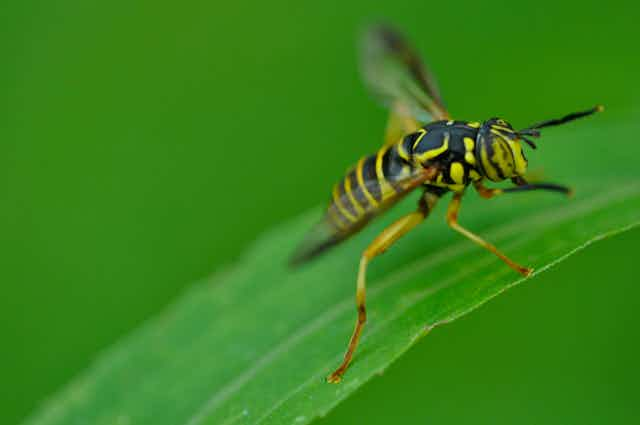In the summer of 2011, panic gripped a small community in Gatineau, Quebec. Hundreds of small, striped insects were buzzing around a children’s playground. The playground was evacuated and entomologists were called in to establish whether or not the animals were dangerous. The answer was no, but it is easy to see why local residents were concerned. The animals that had taken up residence in the playground were hoverflies, a family of harmless fly species that have built up quite an arsenal of tricks to convince would-be predators that they are dangerous.
The panic that a swarm of hoverflies can generate belies the fact that they are immensely beneficial insects. Many of their larvae (the baby hoverflies that look like maggots) crawl around on plants feeding on the aphids that would otherwise eat our flowers and crops. Meanwhile the adults –- the stripy, flying insects that instil such terror –- spend their days pollinating flowers as they feed on nectar and pollen. But flying around in the open leaves hoverflies vulnerable to predators, a problem they have solved by evolving to resemble the stinging, pollinating insects such as bees and wasps with which they share the flowers.
Yet the story is not quite so simple. For every hoverfly that presents an exquisite example of mimicry (like the wonderful Spilomyia longicornis pictured above) there are several that really do not seem to be trying at all. Given that mimicry can obviously benefit hoverflies, why don’t they all evolve such excellent abilities?
Researchers found a potential solution to this Darwinian puzzle in 2012, when they looked into the characteristics of mimicking and non-mimicking hoverflies. You might expect that birds would prefer to eat larger species of hoverfly, since those hoverflies represent a bigger, more rewarding meal. Those larger species would therefore have more to gain from mimicry because they are under greater pressure from predators. Sure enough, it turns out that the colour patterns of the largest hoverflies (which are effectively flying buffets for birds) bear a close resemblance to the yellow, black, and white stripes of wasps and bees. The smallest species (which are barely worth chasing) do not show such similarity.
However, hoverflies have more than just wasp-like costumes. Some species also have considerable acting talents. It has been known for decades that certain hoverflies will pretend to sting when attacked, or hold their dark front legs in front of their heads to make it appear as though their antennae are long like those of wasps.
A recent extensive field survey showed that the species that behaved like wasps and bees were comparatively rare (just like the species that look like wasps and bees). This behavioural mimicry also tended to occur only in those species that already showed a strong visual resemblance to wasps and bees. In other words, those species that had the costumes also had the acting skills.
Insect sound bites
One of the most fascinating aspects of hoverfly mimicry has recently been dissected in great detail. As well as looking like wasps and bees, and acting like wasps and bees, some species also sound like wasps and bees. As part of our most recent project, my colleagues and I caught 172 insects from 13 species of hoverflies and nine species of wasps and bees, and brought them into a soundproofed recording studio. There, they recorded the sounds the insects made during regular flight and when the animal was attacked (simulated using a sharp poke with a pair of tweezers).
When they ran a statistical analysis on these sounds, the researchers found that some species of hoverfly make sounds when they are attacked that are indistinguishable from the high-pitched alarm buzz of bumble bees. The high-pitched buzz that bumble bees make seems to be produced by the bee unhooking its wings from the muscles that drive them, resulting in a completely different sound. This is a bit like what happens when you take your car out of gear and rev the engine – a lot of noise and you don’t go anywhere. It seems that hoverflies are capable of the same behaviour.

But just because statistical analysis can’t tell the difference, that doesn’t mean natural predators can’t. To test for the benefits of this sound imitation in the wild, researchers presented pastry models of insects to wild birds with the different sounds. Pastry has approximately the same nutritional content as the insects that the birds forage on naturally, being part fat and part carbohydrate. The pastry can also be painstakingly painted to resemble insects as well, as in the photo to the right. To the surprise of the researchers, the birds only avoided the bee sounds. This was despite the fact that the hoverflies sounded identical to the computer-based analysis.
So we are left with a situation where an animal brain outperforms human researchers and their technical wizardry, which is not altogether surprising. Birds have evolved alongside a host of potential prey, developing the ability to find safe prey while avoiding animals that sting. While the hoverflies have a complex and fascinating suite of acting skills to dissuade would-be predators, they are still part of an evolutionary “arms race” where predators either keep up or starve.
The best part of this particular story is that it is possible to watch it unfold in your back garden. Next time you see or hear an animal that makes you reach instinctively for the rolled up newspaper, take a minute to check that it isn’t one of nature’s great actors.

